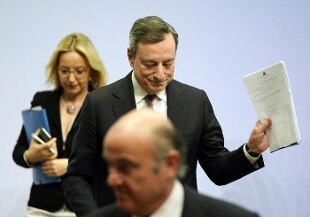- ECB, standing ovation of European leaders for Draghi at his (probable) last Eurosummit
- Bce, Draghi: "In the absence of necessary improvements, further stimuli". Ira of Trump
Share
24 July 2019At the head of the ECB, Mario Draghi made his debut at the end of 2011 with a rate cut. A month before leaving, in September, a striking new 'blow' is likely to be paved for tomorrow's board of directors: a new rate cut, within a package of measures to support the Eurozone economy which could even include a revision of the inflation target and a reopening of quantitative easing.
With Eurozone inflation at 1.3%, according to many economists there would be good reasons for the ECB to immediately cut the cost of money, bringing the rate on liquidity to a day that banks deposit in Frankfurt at -0, 5% from the current historic low of -0.4%. Investors are also on guard for a possible 'surprise' effect from Draghi: traders on the money market give 30% the possibility of an announcement tomorrow.
After all, the president of the ECB is not new to the temptation to amaze the markets, as he did in 2012 with the famous 'whatever it takes'. And to record, just today, for the ECB there is the disappointing data of the SME indexes: growth of the activity of European companies close to stalemate (51.5) which promises to weaken the GDP in the third quarter to +0.2 or + 0.1% (+ 0.3% the second). With an industry in contraction for seven months that has fallen from 47.6 from 46.7, the worst decline in seven months: for Germany, the SME manufacturing collapses to 43.1 from 45, signaling recession for the engine of its economy . However, after announcing in June that "in the absence of an improvement" a new monetary stimulus will be needed, Draghi appears oriented to take action only in September. The advice of tomorrow, as well as to remove the prospect of a rate hike through forward guidance in time, would serve to prepare the basis for a new package of measures: rate cuts in September, recovery of the QE, in fact, and possible revision of the inflation target (2%) in a symmetrical sense, ie explicitly opening to a temporary overrun beyond that level to consolidate the price trend.
On the advice of the ECB, Draghi, who still has three months in office before passing the baton to Christine Lagarde who has just left the IMF, is still consolidating consensus around these new measures. And the probable decision to wait for September would also be dictated by other needs: to wait for data on the GDP and inflation in the Eurozone; have available the new medium-term estimates of ECB economists; to address the technical details (the ECB must decide how to exempt a portion of bank deposits from a penalizing rate that affects the banks' interest margins, and it is possible to revise the limit of 30% of the issues that can be purchased to re-open the Qe); finally, wait for the Fed (which in all probability will cut rates next week) and not give the markets the feeling of excessive alarmism. Except surprises, of course.

